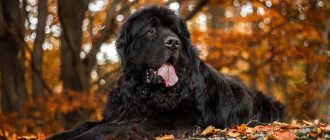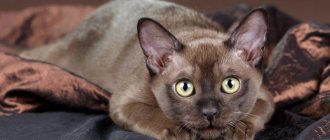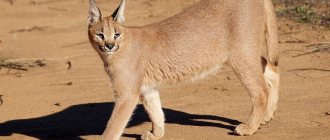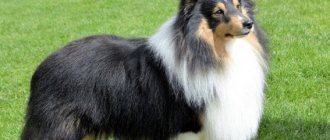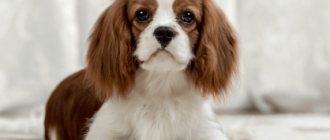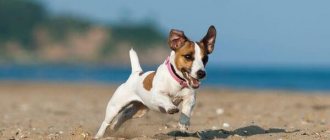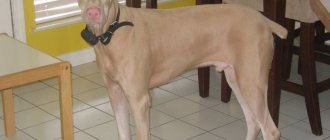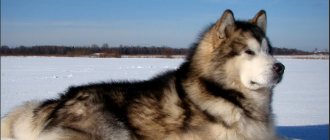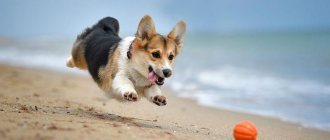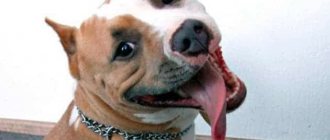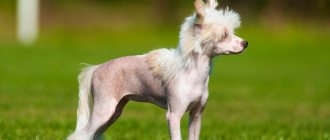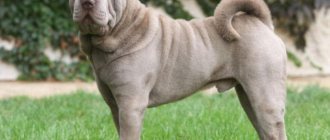Shiba Inu is one of the popular Japanese dog breeds, the smallest. Although it became famous in the world only towards the end of the 20th century. This is an ancient hunting breed, considered a national treasure of Japan. Now these dogs are kept as pets and companions. But they have a complex character, they obey only the owner who can gain authority. The breed is not suitable for everyone, so before getting one, you need to study the description, main characteristics, pros and cons, as well as reviews from the owners.
- Shiba Inu standard
- Training and education of the Shiba Inu
- Content Features
Breed traits
Breed traits (on a 5-point scale)
| Shiba Inu (Shiba Inu) | |||
| Activity | in the house | 3.7 | |
| on the street | 3.8 | ||
| Obedience | training | 2.5 | |
| strangers | 4.4 | ||
| Domination | in family | 2.5 | |
| over dogs | 4.2 | ||
| Defending your territory | from people | 2.2 | |
| from dogs | 4.2 | ||
| Sociability | in family | 4 | |
| with strangers | 3 | ||
| with dogs | 2.5 | ||
| Concentration | in family | 2.5 | |
| in front of strangers | 3.1 | ||
| with dogs | 3 | ||
| Aggressiveness | in family | 1.6 | |
| to strangers | 1.6 | ||
| to the dogs | 3.9 | ||
| to cats | 3.9 | ||
| Family behavior | calmness | 2.4 | |
| demand for affection | 3.2 | ||
| excitability | 3.5 | ||
| playfulness | 4.3 | ||
| excessive barking | 1.6 | ||
| behavioral breakdowns | 1.9 | ||
| Tolerance for children | up to 4 years | 3.3 | |
| over 4 years old | 4 | ||
| Institutional use | watchman | 3.5 | |
| bodyguard | 1.7 | ||
This breed is often compared to the following dog breeds: Pembroke Welsh Corgi, Akita Inu, Basenji, Beagle, Jack Russell Terrier.
Photos of Shiba Inu dogs show what they look like:
What does a Shiba Inu look like?
Appearance
Shiba Inu smile
Shiba Inu
Shiba Ina look
Content
A small dog is very convenient for keeping in an apartment. Shiba behaves neatly and calmly, she is clean and moderately active. Of course, as a puppy she can get dirty and spoil things, but she is far from the destruction that, for example, Labradors cause. Sibs bark very rarely, which will undoubtedly please the neighbors. She should have her own place in the house, secluded and comfortable, from which she can watch everything that happens
It usually gets along poorly with other animals and does not like to share territory.
Even on walks, the Shiba prefers to keep a distance from other dogs and strive for solitude. She can be hostile, especially towards dogs of a different breed and gender. Hunt small animals and birds. Cats annoy her.
Shiba Inu needs moderate, regular exercise.
It is advisable that the dog has the opportunity to walk without a leash. Sibs are very active and energetic and love games. Don’t forget, this dog is a former hunter, on the street it will study smells, tracks, run a lot, can disappear from the owner’s field of vision for a long time, and after coping with all its business, it usually returns.
General characteristics of the Shiba Inu breed
The Shiba Inu is an amazing companion dog with an independent, willful character. She is very smart, active and curious. She immediately attracts attention with her charming fox-like appearance and the unusual structure of her muzzle, thanks to which she seems to be smiling. But despite this and its small size, it will not become a cute, obedient pet.
It’s not easy to cope with a dog; the dog constantly strives to dominate and is difficult to train. Puppies need early socialization, otherwise they become unmanageable. This dog is independent, stubborn and hyperactive. But if you manage to gain authority from her and raise her correctly, she will become an intelligent and cheerful companion, her best friend.
| options | characteristic |
| title translation | small Japanese dog |
| group of breeds according to the ICF classification | Spitz-shaped |
| country of origin | Japan |
| time of origin and recognition | III century BC e., 1936 |
| height | males 38.5-41.5 cm, females 35.5-38.5 cm |
| weight | males 10-14 kg, females 7-10 kg |
| life expectancy | 12-15 years |
| attitude towards a person | rarely shows aggression, kind, cannot stand loneliness |
| content | Not suitable for everyone due to wayward nature |
| training | complex |
| care | sheds a lot |
pros
It is not for nothing that the Shiba Inu breed has become popular all over the world, and in Japan it is a national treasure of the country. There are many advantages to owning this dog:
- has an attractive appearance;
- due to its small size it can be kept in an apartment;
- very clean, does not get into the dirt, licks itself like a cat, quickly learns to use the toilet outside;
- smart, easily learns different tricks;
- does not make noise, rarely barks;
- chooses one owner and becomes strongly attached to him;
- strong, resilient and efficient;
- inquisitive, can become an excellent companion;
- unpretentious in maintenance, not picky in nutrition;
- is in good health and gets sick infrequently;
- unobtrusive, senses when it is better not to touch the owner.
Cons of content
But this breed has disadvantages that make it not suitable for everyone:
- dogs are highly active and require a lot of physical activity;
- at a young age you should not be left alone - they can destroy the apartment, chew furniture and walls;
- the coat is thick and sheds heavily;
- wayward character, difficult to force to obey, as they strive to dominate;
- cunning, touchy, do not like to share toys or treats;
- tend to show their dissatisfaction with unusual sounds;
- often run away;
- have a habit of biting.
The video will tell you about the pros and cons of the Shiba Inu:
Video: Shiba Inu description of the breed Pros and cons of the breed!
Interesting Facts
Despite the fact that the breed became known only in the 20th century, many interesting facts about it have accumulated.
- Shiba or Shiba Inu is also called Shiba-ken in Japan. Translated as mini dog or Japanese dwarf. This is the smallest among Japanese breeds.
- This dog is a symbol of Japan, a national treasure of the country. In honor of them, festivals are organized, toys and clothes with their image are produced.
- These dogs have become popular recently due to the spread of videos and memes on the Internet. They often become the heroes of blogs.
- They are smart, dexterous, jumping. They can learn to open latches on doors and furniture doors. They often climb trees, fences, closets.
- Shiba Inus often panic and can actively show fear or dissatisfaction. They make unusual sounds that do not sound like barking or howling. That's what they call it - the cry of a Shiba Inu.
- They do not like to hug, and do not tolerate annoying caresses. But the Shiba Inu is one of the few dogs that can smile, as reflected in numerous memes on the Internet. The sly expression of the muzzle appears due to the special structure of the jaw.
- In the famous film "Hachiko" an Akita Inu was filmed, but the puppy was played by a Shiba Inu. Externally, the breeds are very similar, the differences are visible mainly in size.
- These dogs are smart and efficient. Previously used as hunting. Now they can be companions, watchmen, rescuers.
Popular memes and pictures with these dogs:
Meme
Shiba at the festive table
Muzzle
Belly up
Diet
The Shiba Inu's homeland is offshore islands, which means its diet will not be exactly the same as what dogs on the mainland are used to. At home, the Shiba menu consists of seafood, seaweed, fish and rice. Most types of meat cause allergies, and many cereals are indigestible. Dry food contains soy and other components that can cause digestive upset and do not provide energy value for your Shiba. The closer the dog's pedigree comes from Japan, the more difficult it is to choose a diet and the more likely it is that the dog will prefer seafood products to meat products.
You should definitely ask the breeder what, when and how to feed your Shiba Inu, instead of experimenting and choosing food yourself.
History of the origin of the Shiba Inu breed
Shiba is one of the oldest Asian breeds, one of the original hunting dogs found on the islands of Japan 3 thousand years ago. Belongs to the group of Spitz-like animals, its closest relatives are Akita Inu, Chow Chow, Shar Pei.
Figurines and remains of similar mini dogs were found in tombs dating back to the 3rd century BC. e. Experts believe that the ancestors of modern Shibas were brought to Japan by immigrants from Korea or China. It was crossed with the original Japanese hunting dogs.
The breed was bred on the island of Honshu; until the 19th century there was no uniform standard. External signs from antiquity have been preserved due to the fact that Japan was isolated. But in the 19th century the country became open to foreigners. In cities, these dogs were crossed with setters and pointers. Therefore, purebred Shiba Inu almost disappeared by the beginning of the 20th century.
In 1928, a decision was made to preserve and restore the indigenous Japanese dog breeds, which survived only in rural areas. The Shiba Inu population began to recover. By 1936, a standard was formed and the breed was made a national treasure. There were several dozen varieties back then.
Due to the Second World War and the distemper epidemic that broke out in the remaining nurseries after it, the breed was again on the verge of extinction. Breeders managed to preserve only three subtypes from which modern dogs emerged. From Mino, the Japanese Shiba Inu took erect triangular ears and a ringed tail. From the Shin-shu they got thick fluffy fur of a reddish color. From san-in - strong bones and muscular physique.
The result was a dog with an attractive appearance, which quickly became popular in Japan. Among all aboriginal dogs, 80% are Shibas. There is a mini variety up to 30 cm in height, as well as a Jomon Shiba with a slimmer build and a different muzzle structure. They are not recognized as a standard.
By the end of the 20th century, other countries became interested in the breed. Dogs began to be exported to Europe and the USA. Due to their unusual exterior qualities, endurance and inquisitive nature, breeders became interested in them. In 1992, the Shiba Inu breed was recognized by the American Canine Association and the International Film Festival. It is now one of the most popular, albeit rare, companion dogs.
Nicknames
For boy
Popular Japanese boy names with meaning:
- Akira - bright.
- Daiki - great glory, nobility.
- Haruki is the shining sun.
- Hinata is a sunflower, facing the sun.
- Hiro is generous.
- Ichiro is the first son.
- Itsuki - forest trees.
- Jiro is the second son.
- Kichiro is a happy son.
- Kiyoshi – purity.
- Kuta is a great world.
- Masaki is a big tree.
- Masato is a righteous man.
- Masumi – true clarity.
- Nao - honestly.
- Nori - edit.
- Osamu – disciplined, diligent.
- Riku is earth.
- Shinobu – endurance.
- Takahiro – valuable, noble.
- Takashi is prosperous.
- Toshi is wise.
- Yasushi – peaceful.
For girl
Popular Japanese nicknames for girls with meaning:
- Akemi is a bright beauty.
- Asami - morning beauty.
- Haru - spring.
- Hideko is a child of perfection.
- Hikari – light, radiance.
- Hiro is generous.
- Hiroko is a generous child.
- Hoshi is a star.
- Kimi is noble.
- Kiyomi is pure beauty.
- May - dance.
- Maiko is a child of dance.
- Maki is true hope.
- Mika is a wonderful scent.
- Miku is a beautiful sky.
- Mio is a beautiful cherry color.
- Misaki is a beautiful flower.
- Natsuki is the summer hope.
- "Peekaboo" is a women's hairstyle.
- Rio - Sakura Village.
- Satoko is a wise child.
- Shinju is a gem.
- Shiori is a poem.
- Sora is the sky.
- Yoshi is a lucky guy.
- "Foxy" is a fox.
- Yuki is happiness.
Description of the Shiba Inu breed
Characteristic features of the appearance of the Shiba Inu are a compact build, a sharp smiling face, triangular ears and a tightly curled tail. They are clearly visible in the photographs.
Smiling face
Triangular ears
Shiba Inu standard
The modern breed standard was adopted in 1964. The description used in the Japanese organization “Nippo” was taken as a basis. According to him, this is a harmoniously built dog with a strong muscular body and an expressive muzzle. Shiba Inu males and females differ from each other in size and have distinct sexual characteristics. In a male, the height at the withers is 39-40 cm, weight – 10-14 kg. Shiba Inu females are smaller - their height is 35-37 cm, weight - 7-10 kg.
Head structure
The head is triangular, shaped like a fox. The forehead is flat, the stop is clearly defined. The muzzle is wide at the base, tapering towards the nose, and the cheekbones are well defined. The eyes are set close to each other, slightly askew. They are small, almond-shaped, dark. The ears are triangular in shape, erect, dense, turned forward. Scissor bite, teeth very sharp. The bridge of the nose is straight, medium-sized, black.
Body type
The physique is proportional and muscular. The neck is strong and flows smoothly into a straight back. The chest is moderately wide, but deep, the stomach is tucked. The tail is long and set high. It is thick and covered with thick fur. A characteristic feature of the Shiba Inu is that the tail curls into a tight ring and lies on the back.
Limbs
The limbs are of medium length, proportional to the body, muscular and strong. Elbows tucked in, hips elongated. The hind limbs are slightly longer than the forelimbs. The hock joints are strongly pronounced. The paw pads are elastic, large, the toes are pressed against each other. The claws are dark and clearly visible. The dog's movements are dexterous, elastic, they jump high.
Pictures complement the description of appearance:
Tail curled tightly
Shiba Inu
In the snow
Features of wool
The coat is dense, thick, and not very long. It has a clearly defined soft and dense undercoat. The guard hair is hard, straight, adjacent to the body. Longer hair on the neck and tail. The dog does not get wet and does not freeze in cold weather.
Shiba Inu colors
The color of these dogs is interesting. The upper surface of their body is dark, the bottom of the muzzle, chest, neck, belly, paws and the inner surface of the tail are white. This color is called urajiro.
The standard recognizes three colors. The most common are red dogs, they can be darker or lighter, from golden to red. Black Shiba Inus with silver or tan markings are often found. A rare beautiful color is called sesame. This is a zone color consisting of three colors, one of which is white. It comes in three varieties:
- red hairs with a black edge;
- black sesame – dark hairs with a small amount of light ones;
- sesame - equal number of black and light hairs.
Differences in the colors of dogs are visible in the photo:
Varieties of Shiba Inu colors
Black and red shiba inu
Red, brown and black color
Disqualifying defects
Light colored, especially white, Shiba Inus are not allowed to show. The color is clearly stated in the standard. In addition to rich primary colors, urajiro is a must. Other defects in appearance include the following:
- drooping ears;
- short tail;
- absence of a ring on the tail;
- deviations from height and weight limits;
- undershot or overshot;
- shaved on the face.
Differences between Shiba Inu and Akita Inu
Sometimes the Shibaina is confused with another Japanese breed, the Akita Inu. Outwardly they are really similar. But the Shiba is a smaller dog than the Akita, its muzzle is sharper, and its hair is shorter. Differences are also visible in character and behavior. Akita is affectionate, calm, and more suitable for protection. The Shiba Inu is naughty and loves to play even as an adult. This is a very active, independent dog that can exhibit destructive behavior.
The difference with the Akita is clearly visible in the photo:
Akita Inu on the left. Shiba Inu on the right.
Akita Inu is taller
Shiba Inu is smaller in size than Akita Inu
Similarities between the Akita Inu and Shiba Inu breeds
Main types of colors
Red
Red color means a deep red or bright red hue.
This color is one of the most common among Shiba Inu. According to the breed standard, this color should be bright, saturated, but without turning into brick.
As for weak shades of red, they receive lower ratings at exhibitions, but are still not considered a defect.
Sashige
The color of sashige is red interspersed with black hairs (not to be confused with sesame). This color is also called dirty red.
The basis here can be absolutely any shade of red, which seems to be sprinkled with black hairs on top. According to the standards, it belongs to the red colors.
Black and Tan
This type of color is considered complex, as it includes several colors:
- Black.
- Red (various intensity).
- Brown.
- White and ashen.
With this color, the undercoat is usually white or ashy. In this case, the lower part of the muzzle, paws, belly and neck are painted in lighter colors, usually red, white, beige or ash.
Sesame
There are several varieties of sesame color. In most cases, the base color is red with the addition of black hairs. The base can also be light red, beige or ashy.
There is also black sesame, when the amount of black wax predominates over the base color.
All colors must have a “urozhiro” effect - light shades on the cheekbones, chest, belly, lower jaw, inside of the paws and under the tail.
Otherwise, the dog will not be allowed to participate in the exhibition.
Shiba Inu character
The Shiba Inu has a willful character. This is a headstrong, independent dog that requires a firm hand. She is prone to dominance, constantly trying to take the place of leader. This is a primitive breed, the ancestors of the Shiba were wolves and ancient hunting dogs. They recently became pets, so their character is dominated by the instincts and traits of wild animals.
- Shiba Inus are distrustful of strangers and do not allow themselves to be touched. They are devoted to only one owner, and even treat other family members, although well, but coolly. They vigilantly defend their territory, although they are not prone to conflicts.
- Shibas are independent and will not fawn or violently express their emotions when their owner returns. They do not like to hug and protect their personal space.
- Smart, cunning, quick-witted. They are able to make their own decisions and are independent. They can open doors, climb into cabinets and drawers. They easily find a way to outwit and deceive the owner in order to achieve their goal.
- Wayward and stubborn. This dog is easy to teach different commands and tricks, and it quickly remembers words. But he doesn’t always do what the owner requires. Young pets especially often ignore commands.
- Very active, curious and resilient. On the street they will run after birds and small animals and love to dig. Due to hunting instincts, even a well-mannered Shiba can run away, not paying attention to the owner’s call. Therefore, you only need to walk on a leash.
- Among other breeds it stands out for its strong possessive instincts. Their place, bowl, toys, and even their owner and territory in the yard are forbidden to others. They try in every way to protect them, often entering into conflicts.
The Shiba Inu is an unusual dog and is often compared to a cat. Some call her "catdog". In addition to their independent character, cats are similar in their dexterity and cleanliness. They can climb trees and climb onto tables and cabinets. Already from puppyhood, they lick themselves like cats, avoid dirt, and do not like water.
It is not recommended to own a Shiba Inu for families with children. With proper upbringing, this dog can become a loyal friend and playmate for teenagers, but it does not like kids. This is an owner, so if there is an attempt on his personal space, toys or food, he can show aggression and even bite.
For the same reason, Shibas do not get along well with other pets. Birds, rodents, and often cats are perceived as prey. They often conflict with other dogs, especially if they are of the same sex. But with the right approach, you can teach them to coexist with children and other pets. To do this, the puppy must grow up with them.
But despite such features, the Shiba is a kind and sociable dog. She becomes attached to her owner, faithful and devoted. If she recognizes him as the leader, she will respect and obey.
Training and education of the Shiba Inu
This dog will only obey a person who has been able to gain authority from it. But she will still constantly check him, defend her independence. Therefore, it is important to immediately find an approach to your pet. Aggression and violence must be eliminated. Physical punishment is unacceptable; you need to be able to come to an agreement with the dog. Shibas love to play pranks, but they do it because of their natural curiosity and hyperactivity.
Raising and training such a pet requires patience. You need to become a dog's friend, partner. Even experienced dog breeders are advised to contact a dog handler who has experience with such dogs. They use their natural characteristics, curiosity and intelligence. The training process should turn into a game. Due to its unusual stubbornness, it is difficult to bribe the Shibu with a treat.
It is very important to start socializing your dog from an early age. Adult Shibas are not at all trainable. The puppy must be immediately taught to respond to its nickname; to do this, call its name every time before feeding. It is important to teach not to be distracted on the street, not to pick up from the ground, not to chase birds and to react correctly to other dogs.
Interesting about the education and training of these dogs in the video:
Video: Shiba Inu training, place, use hockey goal
Video: First rules for a Shiba Inu puppy (Shiba Inu)
Video: Curious Shiba Inu Yoshi - an addicting nature
Who can start
The Shiba Inu is not suitable as a first dog for beginners. It is suitable for experienced dog breeders and dog handlers. The owner must be active, as the pet is very energetic and needs high physical activity. Shiba will be happy to practice freestyle, agility, and frisbee with his owner. He will be a wonderful companion when playing sports or walking in nature. This dog is suitable for strong, self-confident people.
A weak-willed owner will not be able to cope with this cunning dog. She has amazing acting skills and facial expressions. She is ready to achieve what she wants by all means, so you need to be able to firmly say “no” without giving any concessions. You should not get a Shiba in the following cases:
- if you don’t have time to take care of your pet;
- there is no opportunity to walk or run for a long time;
- lacks strength of character;
- small children or small pets live in the house;
- You cannot give such a puppy as a gift.
Pictures and memes from the Internet characterize the behavior of these dogs:
It's time to sleep…
Shiba opened his mouth
Here's your tongue
This smile...
Always ready to have some fun
I want to relax...
Shiba Inu care
Caring for these pets is easy. Shibas are healthy, clean dogs. They are unpretentious in nutrition. They can live both in an apartment and in an enclosure.
Content Features
These dogs can be kept in a house, city apartment or in the yard. They are unpretentious, but you need to take into account their characteristics. At home, such a pet can exhibit destructive behavior. Shibas, especially at a young age, chew on everything: wallpaper, walls, floors, furniture, shoes.
When keeping them on the property, you need to remember that these dogs do not like collars and should not be put on a chain. The pet constantly needs attention. Starting to get bored, the Shiba can dig up the entire garden and dig under the fence. These dogs can climb trees and jump high, so they often run away.
Hygiene
Bathing this dog is often not recommended. 3-4 times a year is enough, after a walk you can wash your paws. Adult Shibas are very clean; they not only avoid dirt, but also lick themselves. Coat care involves brushing it every week; during shedding, it is recommended to do this twice a day. You will need a brush with coarse bristles, a slicker brush, and a metal comb with fine teeth.
The hair between the toes should be shortened so that it does not interfere with walking. If the claws do not grind down, they need to be trimmed. After walking, it is recommended to inspect the pads; cracks may appear on them. To soften them, lubricate them with special oil. You will need to regularly examine and clean your pet's eyes and ears. To prevent tartar, teeth should be brushed with veterinary paste.
Nutrition
These dogs are unpretentious eaters. But the diet must be balanced, be sure to include fish, lamb or rabbit meat, seafood, rice, and vegetables in the diet. Food for your Shiba Inu must be chosen carefully; it should not contain soy, corn, wheat, or chicken. Dogs often have allergic reactions to these products.
It is better to choose food designed specifically for this breed: ABBA Premium Grain Free, Farmina Fun Dog, Monge Dog Specialty Hypoallergenic, Royal Canin Hypoallergenic Moderate Calorie HME23.
An incorrectly selected diet can cause hair loss, skin diseases, and allergies. It is forbidden to give your pet eggs, chocolate, cheese, bones, or nuts. You cannot feed dishes from your own table, fried, salty, spicy foods, or smoked meats. The dog should eat at the same time, from 6 months, 2 times a day. You can’t overfeed; food that the dog hasn’t finished eating must be removed after 15 minutes.
Health
The Shiba Inu is in good health. Genetic abnormalities or hereditary diseases are uncommon in puppies. But sometimes they are characterized by the following pathologies:
- hypothyroidism;
- pigmentation disorder;
- decreased blood clotting;
- hip dysplasia;
- shortened spine;
- retinal atrophy, uevitis, cataracts and other eye diseases;
- renal failure.
Due to their thick, dense coat, these dogs often have parasites. In the warm season, regular antiparasitic treatment is necessary. Every three months you need to give your pet anthelmintic medications.
Health and illness
The Shiba Inu is a genetically strong breed. On average, dogs live 12–15 years and often exceed this milestone.
Interesting! It was the representative of the Shiba Inu who was noted as the longest-living record holder. This was a dog named Pusuke: he lived to be 26 years old and was included in the Guinness Book of Records.
However, allergies, hormonal disorders, eye and musculoskeletal diseases are common in the breed. Often found:
- acute reactions to foods or household chemicals;
- cataract;
- entropion: inversion of the eyelid;
- retinal atrophy;
- uveitis: inflammation of the blood vessels in the eyes, leading to decreased or loss of vision;
- changes in pigmentation: vitiligo, early graying;
- hip dysplasia;
- dislocation of the kneecap;
- osteochondritis dissecans: separation of sections of cartilage from the bone and their displacement into the articular cavity;
- shortened spine;
- hypothyroidism: deficiency of thyroid hormones;
- von Willebrand disease: an inherited systemic disease of the circulatory system, characterized by periodic, unpredictable bleeding.
Elizabethan collar
How to buy a Shiba Inu puppy
Those who want to get a Shiba Inu dog should only buy a puppy from good kennels. They buy a baby at 2-3 months, he must have all the vaccinations required by age, pedigree, and a veterinary passport. You can buy a purebred Japanese in Moscow for a price starting from 20 thousand rubles. Show class dogs can cost more than 100 thousand.
When choosing, you need to pay attention to the living conditions of the animals and the behavior of the parents. You need to take a close look at the puppies themselves. The baby should be active, playful, and curious. The absence of aggression and cowardice is important. Appearance must comply with the standard. When choosing the sex of your pet, you need to take into account that males are more active and independent, while females are affectionate and sociable.
The photo shows what the puppies look like:
Shiba Inu puppies
Puppy
Four puppies
Puppy in the car
To decide whether to get such a dog, you can watch 2 interesting videos:
Video: Top 10 reasons not to get a Shiba Inu
Video: Top 10 reasons why a Shiba Inu is right for you
The Shibainu is an unusual dog, attractive and independent. She is smart, but willful, so she is not suitable for everyone. It should be owned by a person who knows how to gain authority with a pet, can devote enough time to it and provide active walking. In this case, the Shiba will become a devoted friend, kind, loving and obedient.
Purchase Features
If you want to buy a puppy for the soul, and not for mating and exhibitions, you will need approximately 15,000 rubles . But most often such animals are sold at much higher prices; the average price in Russia is about 60,000 rubles . Animals must be vaccinated and have all the necessary documents.
An adult specimen can be purchased cheaper. This is due to the fact that adult dogs are in less demand than puppies. In addition, by the age of one year, Sibu Inus already have a formed character and get used to their owner. It will be difficult for them to adapt, and it will be difficult for a person to make friends with them.
Since bitches are in great demand on the market, their prices are slightly higher. Usually a male dog can be purchased for 10,000 cheaper.
